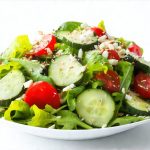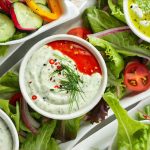That seemingly innocuous bowl of greens – a salad, often touted as the epitome of healthy eating – can sometimes trigger an unwelcome wave of nausea or general queasiness. It’s a frustrating paradox: something good for you making you feel decidedly unwell. This isn’t necessarily a sign that salads are bad, or that your body is rejecting wholesome foods. Rather, it points to a complex interplay between digestive processes, individual sensitivities, and the often-overlooked components within those vibrant leaves and crisp vegetables. Understanding why this happens requires delving beyond simply labeling it “salad sensitivity” and exploring the myriad potential causes, from ingredient combinations to underlying digestive conditions.
The experience can range from mild discomfort – a slight churning in your stomach after finishing your meal – to more pronounced symptoms like bloating, gas, or even brief episodes of nausea. It’s surprisingly common, and many people simply adapt by avoiding salads altogether, missing out on the nutritional benefits they offer. However, identifying the root cause is often possible, allowing individuals to modify their salad preparation or dietary choices to enjoy this healthy meal without unwelcome side effects. The key lies in recognizing that “salad” isn’t a monolithic entity; it’s a diverse collection of ingredients, each with its own potential impact on your digestive system.
The Culprit Components: Beyond Just the Greens
Salads aren’t just about lettuce. They’re often brimming with a variety of ingredients, and it’s frequently these additional components that contribute to queasiness. Consider the dressing – even seemingly benign vinaigrettes can contain ingredients like citric acid or emulsifiers that some individuals struggle with. Then there are the crunchy additions: seeds, nuts, croutons, all requiring digestion. But perhaps most importantly, many salad staples are high in FODMAPs, fermentable carbohydrates that can cause digestive distress in sensitive individuals.
- High FODMAP vegetables include onions, garlic, artichokes and even some seemingly harmless greens like broccoli.
- Nuts and seeds, while healthy fats, also contribute to the overall carbohydrate load and can be difficult for some to digest quickly.
- Dressings often contain ingredients that exacerbate FODMAP sensitivities – honey, high-fructose corn syrup, or dairy products (for those with lactose intolerance).
The combination of these factors creates a perfect storm for digestive upset. Even seemingly simple combinations can trigger symptoms in susceptible individuals. It’s not always about an allergy; it’s often about how your gut tolerates different types of carbohydrates and fats. Furthermore, the raw nature of many salad ingredients means they require more effort from the digestive system compared to cooked foods, potentially overwhelming sensitive systems. This is why people who typically tolerate cooked vegetables may experience discomfort after a raw vegetable-heavy salad.
Finally, it’s worth noting that ingredient freshness plays a role. Wilted or slightly spoiled greens can harbor bacteria or undergo chemical changes that contribute to nausea. Thorough washing and proper storage are therefore crucial for minimizing this risk. Focusing on organic options whenever possible can also reduce exposure to pesticides which might irritate the digestive system.
Digestive Sensitivities & Underlying Conditions
The feeling of queasiness after a salad isn’t always directly attributable to the salad itself. Often, it’s an amplification of underlying digestive sensitivities or conditions that are already present. Irritable Bowel Syndrome (IBS) is a common culprit, characterized by heightened sensitivity to certain foods and an increased likelihood of experiencing bloating, gas, and nausea. Individuals with IBS often find their symptoms exacerbated by high-FODMAP foods frequently found in salads.
Beyond IBS, other conditions can contribute:
* Small Intestinal Bacterial Overgrowth (SIBO) – where excessive bacteria in the small intestine ferment carbohydrates, leading to gas and bloating.
* Lactose intolerance – making dairy-based dressings a problematic component.
* Gastroparesis – slowed stomach emptying, causing food to sit longer and potentially triggering nausea.
It’s important to understand that these conditions might be undiagnosed. If you consistently experience queasiness after salads (or other meals), it’s worth consulting with a healthcare professional to rule out underlying medical issues. Self-diagnosis can be misleading, and proper evaluation is essential for targeted treatment or dietary adjustments. Don’t simply assume it’s “just salad sensitivity” without investigating further. You might even find relief from bloating after crying can sometimes help manage the discomfort.
The Role of Fiber & Gut Microbiome
Salads are, by their very nature, high in fiber. While fiber is generally beneficial for digestive health, a sudden increase in fiber intake can overwhelm the system, particularly if you’re not accustomed to it. This can lead to bloating, gas, and even nausea as your gut microbiome adjusts. The gut microbiome – the trillions of bacteria residing in your intestines – plays a vital role in breaking down food. If your microbiome is imbalanced (dysbiosis), it may struggle to efficiently process the fiber from salad ingredients, leading to fermentation and subsequent discomfort.
Building up your fiber intake gradually can help mitigate this issue. Start with smaller salads containing easily digestible greens like romaine lettuce and slowly introduce other vegetables over time. Supporting a healthy gut microbiome through probiotic-rich foods (yogurt, kefir) or supplements can also improve your ability to process fiber effectively. It’s not about eliminating fiber; it’s about optimizing your gut’s capacity to handle it. In some cases, you may even find that you are more gassy after starting probiotics as your system adjusts.
Decoding Your Salad: A Step-by-Step Approach
If you suspect salads are causing your queasiness, a systematic approach to identifying the trigger is crucial. Start by keeping a food diary, meticulously recording everything you eat and any associated symptoms. Pay attention not just to the salad itself but also to anything else consumed around the same time. This can help pinpoint specific ingredients or combinations that seem problematic.
- Simplify: Begin with a very basic salad – romaine lettuce, cucumber, and a simple olive oil & lemon juice dressing. Observe if symptoms persist.
- Introduce One New Ingredient at a Time: If the basic salad is well-tolerated, gradually add one new ingredient per day (e.g., tomatoes, carrots, bell peppers). Monitor for any changes in your digestive system.
- Experiment with Dressings: Test different dressings – vinaigrette, tahini-based, or even just olive oil and herbs – to identify potential sensitivities. Avoid creamy or dairy-based options if you suspect lactose intolerance.
- Consider Cooking Some Vegetables: For those highly sensitive, lightly steaming or roasting vegetables before adding them to the salad can make them easier to digest.
Remember to be patient and observant. It may take time to identify the specific culprit(s). And always consult with a healthcare professional if your symptoms are severe or persistent. Don’t assume you must eliminate salads entirely; often, simple adjustments can restore your ability to enjoy this healthy and nutritious meal without discomfort. You might also want to consider if taking supplements is contributing to your digestive issues, as this can sometimes mimic salad sensitivities. Understanding small meals and their impact on bloating can also be helpful in managing symptoms. If you’ve recently changed your diet, such as switching to veganism, these changes could also play a role.


















